Other Solved Mathematics Board Papers
MATHEMATICS (ICSE – Class X Board Paper 2016)
Two and Half Hour. Answers to this Paper must be written on the paper provided separately. You will not be allowed to write during the first 15 minutes. This time is to be spent in reading the question paper.
The time given at the head of this Paper is the time allowed for writing the answers. Attempt all questions form Section A and any four questions from Section B. All working, including rough work, must be clearly shown and must be done on the same sheet as the rest of the Answer. Omission of essential working will result in the loss of marks.
The intended marks for questions or parts of questions are given in brackets [ ].
Mathematical tables are provided.
SECTION A [40 Marks]
(Answer all questions from this Section.)
Question 1
(a) Using remainder theorem, find the value of if on dividing
, leaves a remainder of
[3]
(c) The mean of the following numbers is Find the value of
Hence estimate the medium. [3]
Answers:
(a) Let
By remainder theorem, when is divided by
means
,
, then the remainder is
Therefore
Since LHS = RHS
Also
Hence the value of
Now arrange the numbers in ascending order we get
Question 2
(b) Without using trigonometrical tables evaluate:
(c) A certain number of metallic cones, each of radius 2 cm and height 3 cm are melted and, recast into a solid, sphere of radius 6 cm. Find, the number of cones. [3]
Answers:
(a)
(b) Given:
(c) Let number of cones
Volume of cones = Volume of sphere [Provide Formulas]
Therefore the number of cones needed is
Question 3
(a) Solve the following inequation, write the solution set and represent it on number line.
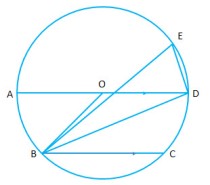 (b) In the given figure below, AD is the diameter. O is the center of the circle. AD is parallel to
(b) In the given figure below, AD is the diameter. O is the center of the circle. AD is parallel to Find: i)
ii)
iii)
[4]
[3]
Answers:
(a)
Therefore we have:
Also we have
Combining i) and ii) we get

(b) Given
Therefore (alternate angles)
Since (radius of the same circle)
Therefore (angles opposite to equal side of the triangle are equal)
(angle at the center is twice that subtended at the circumference)
In
(sum of the angles of a triangle is
)
(angle in the same segment)
Therefore
(c)
Cross multiplying
Question 4
(a) A game of number has cards marked with A card is drawn at random. Find the probability that the number on the card drawn is: i) A perfect square ii) Divisible by 7 [3]
(b) Use graph paper for, this question. (Take unit along both
). Plot the point
[4]
Reflect points on the y axis and name them
respectively. i) Write down their coordinates. ii) Name the figure
iii) State the line of symmetry of this figure
(c) Mr. Lalit invested Rs. 5000 at a certain rate of interest, compounded annually for two years. At the end of first year it amounts Rs. 5325 . Calculate: i) The rate of interest. ii) The amount at the end of second year, to the nearest rupee. [3]
Answers:
(a) Total number of all possible outcomes
i) The cards with perfect squares are:
The number of favorable outcomes
ii) The cards with numbers divisible by are:
Therefore the number of favorable outcomes
(b)
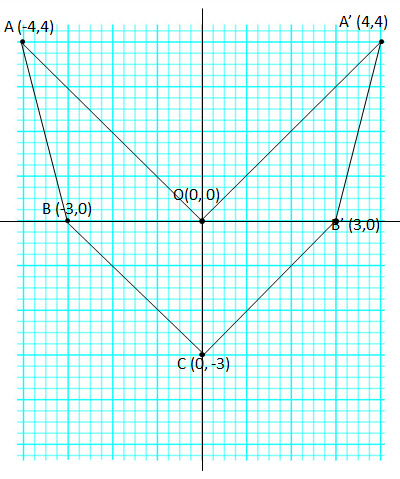
i)
ii) Arrow Head
iii) is the line of symmetry
(c) Given: Principal
i) We know that Amount
ii) Amount (A) at the end of
SECTION B [40 Marks]
(Answer any four questions in this Section.)
Question 5
(a) Solve the quadratic equation Give answer correct to three significant figures. [3]
(b) A page form the saving bank account of Mrs. Ravi is given below:
| Date | Particulars | Withdrawal (Rs.) | Deposit (Rs.) | Balance (Rs.) |
| April 3rd 2006 | B / F | – | – | 6,000 |
| April 7th | By Cash | – | 2,300 | 8,300 |
| April 15th | By Cheque | – | 3,500 | 11,800 |
| May 20th | To Self | 4,200 | – | 7,600 |
| June 10th | By Cash | – | 5,800 | 13,400 |
| June 15th | To Self | 3,100 | – | 10,300 |
| August 13th | By Cheque | – | 1,000 | 11,300 |
| August 25th | To Self | 7,400 | – | 3,900 |
| September 6th 2006 | By Cash | – | 2,000 | 5,900 |
She closed the account an 30th September, 2006 . Calculate the interest Mrs. Ravi earned, at the end of 30th September, 2006 at 4.5% per annunm interest. Hence find the amount she receives on closing the account. [4]
(c) In what time will Rs. 1500 yield Rs. 1996.50 as compound interest at 15% per annum compounded annually ? [3]
Answers:
(a) Given
Comparing with
, we get
Solving we get
(b) Qualifying principal for various months:
| Month | Qualifying Principal (Rs.) |
| April | 8300 |
| May | 7600 |
| June | 10300 |
| July | 10300 |
| August | 3900 |
| Total | 40400 |
Amount received on 30th September (on closing the account)
(c) Given
Question 6
(a) Construct a regular hexagon of side 5 cm. $ Hence construct all its lines of symmetry and name them. [3]
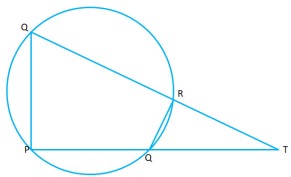 (b) In the given figure
(b) In the given figure is a cyclic quadrilateral
produced meet at point
i) Prove
ii) Find.
iii) Find area, of quadrilateral if area of
[4]
If, : i) Write the order of matrix
ii) Find the matrix
[3]
Answers:
(a)
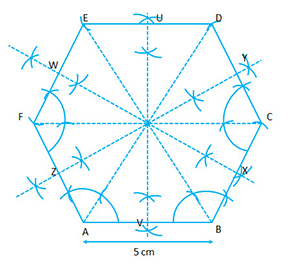 Step 1: Given side of the hexagon is
Step 1: Given side of the hexagon is Construct the hexagon as follows:
- First draw a line using a ruler of length 5 cm. Mark it AB.
- The using a compass, make an arc of
- Using compass, draw 120 degree angle and cut the line into 5 cm lengths using the compass. Continue this until the hexagon is completed
- One the hexagon is completed, draw perpendicular bisectors of each of the arms of the hexagon. You will get mid point for each of the arms of hexagon as marked
- Now join the mid points of the opposite sides to get lines
- Now draw the diagonals passing through the center to get lines
The six lines of symmetry
(b)
(i) Consider
Since exterior angle of cyclic quadrilateral is equal to the interior opposite angle, we get
is common
Therefore
(ii) Since
(iii) Since
Therefore Area of quadrilateral
If, :
(i) From the given matrix, order of and order of
We know
Hence
Therefore the order of
Therefore
Solving i) and ii) we get
Question 7
(a) An aero plane is at a height of 1500 meters finds that two ships are sailing towards it in the same direction. The angle of depression as observed from the aero plane are respectively. Find the distance between the two ships. [4]
(b) The table shows the distribution of the scores obtained by 160 shooters in a shooting competition. Use a graph sheet and draw an ogive of the distribution.
(Take scores on the
shooters on the
).
| Scores | 0-10 | 10-20 | 20-30 | 30-40 | 40-50 | 50-60 | 60-70 | 70-80 | 80-90 | 90-100 |
| No of shooters | 9 | 13 | 20 | 26 | 30 | 22 | 15 | 10 | 8 | 7 |
Use your graph to estimate the following: i) The median. ii) The interquartile range. iii) The number of shooters who obtained a score of more than 85%. [6]
Answer:
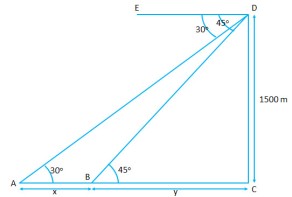 (a) In the adjacent diagram, let
(a) In the adjacent diagram, let be the air plane and
be the two ships.
Given:
Consider
Consider
Therefore
Hence, distance between two ships
(b)
| Scores | No of Shooters | Cumulative Frequency (c.f.) |
| 0-10 | 9 | 9 |
| 10-20 | 13 | 22 |
| 20-30 | 20 | 42 |
| 30-40 | 26 | 68 |
| 40-50 | 30 | 98 |
| 50-60 | 22 | 120 |
| 60-70 | 15 | 135 |
| 70-80 | 10 | 145 |
| 80-90 | 8 | 153 |
| 90-100 | 7 | 160 |
(i) (which is even)
From the graph, Median
Inter Quartile range
(iii) The number of shooter who obtained a score of more (using the graph)
Question 8
(b) Draw, a line Mark a point
such that
Using a ruler and compass only, construct:
(i) A circle of radius , passing through
(ii) Construct two tangents to the circle from the external point Measure and record the length of the tangents. [4]
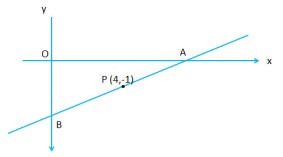
(i) Find the coordinates of
(ii) Find the equation of the line through and perpendicular to
[3]
Answers:
Therefore
Substituting
(b)
- First draw line
This you can just draw by using a ruler.
- From
cut
This can be done by using a compass. Set the compass at 3 cm and then make this arc cutting AB at C.
- Draw perpendicular bisector of
- Taking
as center and
radius, draw an arc to meet the perpendicular bisector of
- Taking
as the center and
as radius, draw a circle, which passing through
- Join
- Draw right bisector of
, which cuts
- Taking
as center and
as radius, draw a circle which cuts old Circle at
- Join
These are required tangents.
(ii) Length of tangent
(c)
(i) Let coordinates of
The coordinate of a point divides it in the ratio
If a point divides two points in the ratio
, then the coordinates of the point at
Therefore
Therefore coordinates are
Required equation of the line:
Question 9
(a) A dealer buys an article at a discount of 30% from the wholesaler, the marked price being Rs. 6,000. The dealer sells it to a shopkeeper at a discount of 10% on the marked price. If the rate of VAT is 6%, find:
(i) The price paid by the shopkeeper including the tax.
(ii) The VAT paid by the dealer. [3]
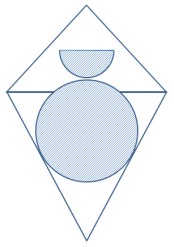 (b) The given figure represents a kite with a, circular and a Semicircular motifs stuck on it. The radius of circle is
(b) The given figure represents a kite with a, circular and a Semicircular motifs stuck on it. The radius of circle is and the semicircle is
If diagonals
are the lengths
respectively, find the area of the :
(i) shaded, part. Give your answer correct to the nearest whole number.
(ii) unshaded part. [4]
(c) A model of a ship is made to a scale
(i) The length of the model of the ship is Calculate the length of the ship.
(ii) The area of the deck ship is Calculate the area of the deck of the model.
(iii) The volume of the model is Calculate the volume of the ship. [3]
Answers
(a) Given: Market Price Rate of discount
Therefore the cost price of the article for the dealer
Sales tax paid by the dealer to the wholesaler
(i) Discount rate for shop keeper
The cost price for the shopkeeper
The price paid by the shopkeeper including the tax
(ii) VAT paid by the dealer = Tax charged – Tax paid
(b)
(i) Given: Radius of circle Radius of semicircle
Area of shaded part = Area of semicircle + Area of circle
(ii) Let kite be a quadrilateral.
Area of the unshaded part = Area of kite – Area of shaded part
Length of the ship
Volume of the ship
Question 10
(a) Mohan has a recurring deposit account in a bank for 2 years at 6% p.a. simple interest. If he gets Rs. 1200 as interest at the time of maturity, find:
(i) the monthly installment
(ii) the amount of maturity [3]
(b) The histogram below represents the scores obtained by 25 students in a Mathematics mental test. Use the data to:
(i) Frame a frequency distribution, table.
(ii) To calculate mean.
(iii) To determine the Modal class. [4]
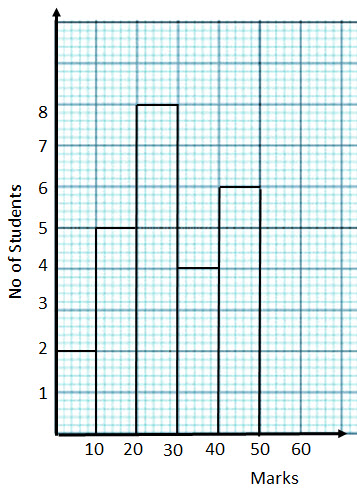
(c) A bus covers a distance of 240 km at a uniform speed. Due to heavy rain its speed gets reduced by 10 km/hr and as such it takes two hrs longer to cover the total distance. Assuming the uniform speed to be form an equation and solve it to evaluate
[3]
Answers
(a) the number of months for which the money is deposited
(i) Let the monthly instalment be
Using the formula:
Therefore the monthly instalment
(ii) The amount at maturity = Total money deposited + interest
(b)
(i) Frequency Distribution Table
| C.I | Frequency |
| 0-10 | 2 |
| 10-20 | 5 |
| 20-30 | 8 |
| 30-40 | 4 |
| 40-50 | 6 |
(ii) Mean
| C.I | |||
| 0-10 | 2 | 5 | 10 |
| 10-20 | 5 | 15 | 75 |
| 20-30 | 8 | 25 | 200 |
| 30-40 | 4 | 35 | 140 |
| 40-50 | 6 | 45 | 270 |
(iii) Model Class = 20-30
Given that the return time is 2 hours more, we have
Hence
Question 11
(b) Use ruler and compasses only for the following question. All construction lines and arcs much be clearly shown.
(i) Construct a in which
(ii) Construct the locus of points at a distance of from
(iii) Construct the locus of points equidistant from
(iv) Mark points
which are at a distance of
from
and also equidistant from
Measure
[4]
(c) Ashok invested Rs. 26,400 on 12%, Rs. 25 shares of a company. If he receives a dividend of Rs. 2,475 find the :
(i) number of shares he bought.
(ii) Market value of each share. [3]
Answers
= RHS Hence Proved
(b)
- Construct
Draw a line BC which is 6.5 cm long. The using your compass, make an angle of
at point B of line BC.
- The taking the compass, make a cut a 5 cm mark on the side of the angle to mark A. AB is 5 cm long.
- Taking
as center and radius is
, draw a circle. This has been told in the question. Which is required locus.
- Draw an angle bisector of
Angle bisector of
cut above circle at two points i.e.,
These points are required points.
- Measure the length of
(c)
(i) Let number of shares be
Face Value of x shares

Thank you so much! It helped me a lot.